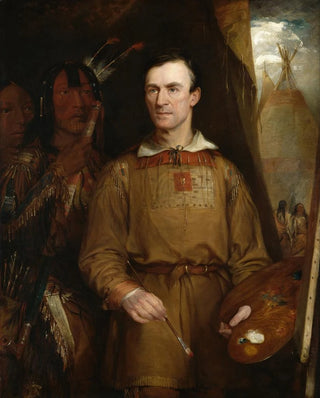Art print | Georges Catlin - William Fisk Source: Reproduction | Georges Catlin - William Fisk


View from behind

Frame (optional)
Georges Catlin - William Fisk art print
The canvas titled "William Fisk" by Georges Catlin is part of an artistic tradition that celebrates not only the beauty of portraits but also the cultural richness of Indigenous peoples of America. Created in the 19th century, this work is much more than a simple representation; it is a poignant testament to the identity and history of a rapidly changing era. Catlin, with his sharp eye and keen sense of observation, manages to capture the very essence of his subjects, paying tribute to their dignity and culture. The Georges Catlin - William Fisk art print allows for rediscovering this iconic piece while offering an immersion into a rich and evocative visual universe.
Style and uniqueness of the work
The "William Fisk" piece stands out for its vibrant color palette and meticulous attention to detail. Catlin excels in depicting the physical traits of his subject, but also in reproducing the cultural environment surrounding him. Every element, from traditional costume to accessories, is carefully chosen to reflect the character's identity. William Fisk's posture, imbued with dignity, testifies to the pride of the peoples he represents. Catlin's style, oscillating between realism and romanticism, allows the viewer to feel a deep connection with the subject. The composition, both balanced and dynamic, guides the eye and provokes reflection on the identity and cultural issues of the time.
The artist and his influence
Georges Catlin, painter and ethnographer, is often considered one of the first to document Native American cultures through his art. His commitment to preserving the traditions and lifestyles of Indigenous peoples is evident in each of his works. Catlin traveled across the United States, meeting and painting members of various tribes, which enabled him to build a vast collection of works that testify to the cultural diversity of the era. His influence is not limited to his time; it still resonates today in the worlds of art and anthropology. By highlighting subjects often overlooked by his contemporaries, Catlin paved the way for broader recognition of Native American cultures in Western art.

Matte finish

View from behind

Frame (optional)
Georges Catlin - William Fisk art print
The canvas titled "William Fisk" by Georges Catlin is part of an artistic tradition that celebrates not only the beauty of portraits but also the cultural richness of Indigenous peoples of America. Created in the 19th century, this work is much more than a simple representation; it is a poignant testament to the identity and history of a rapidly changing era. Catlin, with his sharp eye and keen sense of observation, manages to capture the very essence of his subjects, paying tribute to their dignity and culture. The Georges Catlin - William Fisk art print allows for rediscovering this iconic piece while offering an immersion into a rich and evocative visual universe.
Style and uniqueness of the work
The "William Fisk" piece stands out for its vibrant color palette and meticulous attention to detail. Catlin excels in depicting the physical traits of his subject, but also in reproducing the cultural environment surrounding him. Every element, from traditional costume to accessories, is carefully chosen to reflect the character's identity. William Fisk's posture, imbued with dignity, testifies to the pride of the peoples he represents. Catlin's style, oscillating between realism and romanticism, allows the viewer to feel a deep connection with the subject. The composition, both balanced and dynamic, guides the eye and provokes reflection on the identity and cultural issues of the time.
The artist and his influence
Georges Catlin, painter and ethnographer, is often considered one of the first to document Native American cultures through his art. His commitment to preserving the traditions and lifestyles of Indigenous peoples is evident in each of his works. Catlin traveled across the United States, meeting and painting members of various tribes, which enabled him to build a vast collection of works that testify to the cultural diversity of the era. His influence is not limited to his time; it still resonates today in the worlds of art and anthropology. By highlighting subjects often overlooked by his contemporaries, Catlin paved the way for broader recognition of Native American cultures in Western art.






